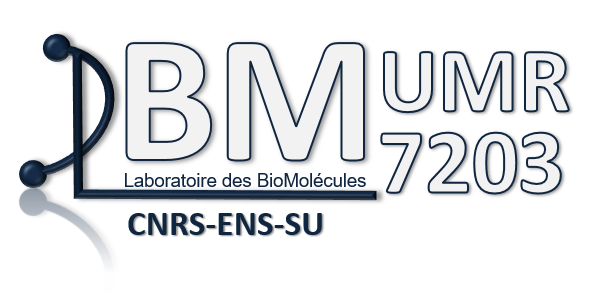
Catégories :
Teams
Structure and dynamics of biomolecules
A large part of the team’s activity concerns the various methodological developments of NMR, in the fields of solution and solid phase spectroscopy. The laboratory has a state-of-the-art instrumentation, including in particular an 800 MHz spectrometer allowing to perform solid and liquid phase experiments as well as micro-imaging. Moreover, which is particularly interesting in the context of the DIM MaTerRE, dynamic nuclear polarization (DNP) experiments in solid phase can be performed thanks to the gyrotron associated with the spectrometer, allowing to perform solid phase spectroscopy experiments with rotation at the “magic angle” and DNP (MAS-DNP) with a gain in sensitivity that can go up to a factor of about 50 in favorable cases In the context of CO2 storage, for example, the application of this technique to the study of porous materials would be particularly adapted by allowing a very good impregnation of the sample by the solution containing the stable radical.
Using solid-state NMR, we are interested in probing functional materials, particularly on obtaining structural information with atomic resolution. We specialized in probing nuclei that suffers from low NMR sensitivity, either via hyperpolarization techniques or with custom-built probes. Moreover, we can also study dynamics by performing NMR experiments at variable temperatures (1.2 K – 350 K).
In addition, dissolution dynamic nuclear polarization (D-DNP) techniques, by providing sensitivity gains of up to 10000 in solution, allow for the implementation of experiments impossible to perform under usual conditions. We have at our disposal such an instrumentation, present only in very few laboratories in France and in the world. Such sensitivity enhancements make it possible to explore dynamical processes, in particular chemical reactions.
Besides, we also develop new NMR methodologies (long-lived spin states, …) that can be also be applied to investigate chemical reactions, and in the context of CO2 release/capture, among others.
Finally, innovative high-resolution relaxometry technologies enable spin relaxation measurements at fields ranging from 14.1 T down to 0.3 T, opening the way to even more comprehensive dynamic explorations. The methodological and instrumental developments of the team will also allow to enter in synergy with the applications addressed in the DIM MaTerRe.
Team members
• ABERGEL Daniel
• BAUDIN Mathieu
• FERRAGE Fabien
• TAN Kong Ooi
• SHEBERSTOV Kirill
• THALAKOTTOR Vineeth
Platforms and equipement
• 800 MHz NMR spectrometer (wide bore) with solid-state NMR, dynamic nuclear polarization capabilities (MAS-DNP and Dissolution-DNP) – Low gamma nuclei capability.
• 400 MHz NMR spectrometer with Dissolution-DNP and EPR capabilities
• 600 MHz NMR spectrometer equipped with high-field relaxometry instrumentation
Publications of interest
• Lu, W., Pang, Z., Lamaire, A., Liu, F., Dai, S., Pinto, M.L., Demir-Cakan, R., Ooi Tan, K., Van Speybroeck, V., Pimenta, V. and Serre, C. (2024), Unraveling the Mechanisms of Zirconium Metal–Organic Frameworks-Based Mixed-Matrix Membranes Preventing Polysulfide Shuttling. Small Sci., 4: 2300339. https://doi.org/10.1002/smsc.202300339
• C. Amerein, U. Banerjee, Z. Pang, W. Lu, V. Pimenta, K. O. Tan, (2023) “In-house fabrication of 1.3 to 7 mm MAS drive caps using desktop 3D printers”, Journal of Magnetic Resonance, 348, 107391, DOI: 10.1016/j.jmr.2023.107391
• D. Carnevale, G. Mouchaham, S.Wang, M. Baudin, C. Serre, Bodenhausen, D. Abergel (2021) “Natural abundance oxygen-17 solid-state NMR of metal organic frameworks enhanced by dynamic nuclear polarization”, PCCP, 23, 2245-2251, doi: 10.1039/D0CP06064J

